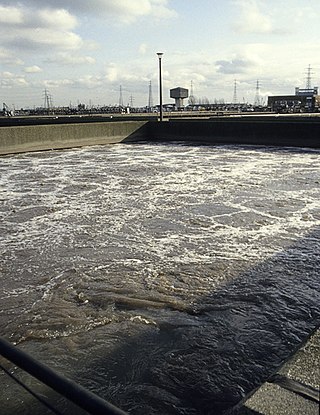
Parabens are chemicals that are commonly used as preservatives in cosmetic and pharmaceutical products. Chemically, they are a series of parahydroxybenzoates or esters of parahydroxybenzoic acid. Research is being conducted to evaluate the potential health implications of paraben usage.

The activated sludgeprocess is a type of biological wastewater treatment process for treating sewage or industrial wastewaters using aeration and a biological floc composed of bacteria and protozoa. It uses air and microorganisms to biologically oxidize organic pollutants, producing a waste sludge containing the oxidized material.

The Nocardiaceae are a family of aerobic, non-fastidious, high G+C, Gram-positive actinomycetes that are commonly found in soil and water. Members of this family have been isolated from Antarctic soils. Nocardiaceae present coccobacilli, filamentous or, rarely, fragmented and palisading forms, and filamentous species grow in a branching morphological pattern similar to fungal hyphae.

Sewage treatment is a type of wastewater treatment which aims to remove contaminants from sewage to produce an effluent that is suitable to discharge to the surrounding environment or an intended reuse application, thereby preventing water pollution from raw sewage discharges. Sewage contains wastewater from households and businesses and possibly pre-treated industrial wastewater. There are a high number of sewage treatment processes to choose from. These can range from decentralized systems to large centralized systems involving a network of pipes and pump stations which convey the sewage to a treatment plant. For cities that have a combined sewer, the sewers will also carry urban runoff (stormwater) to the sewage treatment plant. Sewage treatment often involves two main stages, called primary and secondary treatment, while advanced treatment also incorporates a tertiary treatment stage with polishing processes and nutrient removal. Secondary treatment can reduce organic matter from sewage, using aerobic or anaerobic biological processes.
Gordonia polyisoprenivorans is a rubber-degrading actinomycete first isolated from an automobile tyre.
Gordonia alkanivorans is a bacterium from the genus of Gordonia which has been isolated from soil which was contaminated with tar and phenol in Rositz in Germany. Gordonia alkanivorans has the ability to metabolize hexadecane. The strain RIPI90A of Gordonia alkanivorans can desulfurize dibenzothiophene.
Gordonia caeni is a Gram-positive, strictly aerobic, short-rod-shaped and non-motile bacterium from the genus Gordonia which has been isolated from sludge from a sewage disposal plant in Daejeon in Korea.
Gordonia defluvii is a Gram-positive and non-motile bacterium from the genus Gordonia which has been isolated from activated sludge foams in Australia.
Jongsikchunia kroppenstedtii is a bacterium from the genus Jongsikchunia which has been isolated from polluted stream in Gumi, Korea. Jongsikchunia kroppenstedtii has the ability to degrade phenol.
Gordonia malaquae is a bacterium from the genus Gordonia which has been isolated from sludge from a wastewater treatment plant in Taiwan.
Gordonia neofelifaecis is a bacterium from the genus Gordonia which has been isolated from faeces from the leopard in the Sichuan Province in China.
Gordonia paraffinivorans is a bacterium from the genus Gordonia which has been isolated from the Daqing Oil Field in China. Gordonia paraffinivorans has the ability to degrade hydrocarbon.
Caenibius tardaugens is an oestradiol-degrading bacterium from the family Hyphomicrobiaceae which has been isolated from activated sludge from a sewage treatment plant in Japan.
Candidimonas humi is a Gram-negative bacterium from the genus Candidimonas which has been isolated from sewage sludge in Portugal.
Tepidanaerobacter syntrophicus is an anaerobic, moderately thermophilic and syntrophic bacterium from the genus of Tepidanaerobacter which has been isolated from sewage sludge in Niigata in Japan.
Humibacter albus is a Gram-positive, strictly aerobic and motile bacterium from the genus Humibacter which has been isolated from sewage sludge from Porto in Portugal.
Steroidobacter denitrificans is a Gram-negative and motile bacterium from the genus of Steroidobacter which has been isolated from anoxic sewage sludge from Soers in Germany. Steroidobacter denitrificans has the ability to degrade steroid hormones.
Stenotrophomonas chelatiphaga is an aerobic, Gram-positive and motile bacterium from the genus of Stenotrophomonas which has been isolated from sewage sludge from Kazan in Russia. Stenotrophomonas chelatiphaga has the ability to degrade Ethylenediaminetetraacetic acid.
Cloacibacillus evryensis is a Gram-negative, anaerobic, mesophilic, rod-shaped and non-motile bacterium from the genus of Cloacibacillus which has been isolated from sewage sludge from a wastewater treatment plant from Evry in France.
Pseudoclavibacter caeni is a Gram-positive, strictly aerobic, rod-shaped and non-motile bacterium from the genus Pseudoclavibacter which has been isolated from sludge from a sewage plant from Daejeon in Korea.



